3.3 Exploring CRSP Data with Python#
This script demonstrates how to explore and analyze CRSP daily stock data using various Python plotting libraries.
Overview#
We’ll analyze CRSP daily stock data for selected stocks (AAPL, JNJ, TSLA) and compare their performance against the S&P 500 index. The analysis includes:
Cumulative returns comparison
Dividend analysis
Rolling volatility analysis
Multiple plotting approaches (Matplotlib, Seaborn, Plotly)
Data Source#
CRSP Daily Stock File v2 (DSF) via WRDS
Filtered for common stock universe with proper exchange and trading filters
Date range: 2019-2025
import pandas as pd
import numpy as np
import wrds
import matplotlib.pyplot as plt
import seaborn as sns
import plotly.express as px
import plotly.graph_objects as go
from plotly.subplots import make_subplots
from datetime import datetime, timedelta
import config
DATA_DIR = config.DATA_DIR
WRDS_USERNAME = config.WRDS_USERNAME
db = wrds.Connection(wrds_username=WRDS_USERNAME)
Loading library list...
Done
Understanding CRSP Data Structure#
To find the right table, we use a combination of the web query interface and the SAS Studio explorer. The web query interface is available at: https://wrds-www.wharton.upenn.edu/pages/get-data/center-research-security-prices-crsp/annual-update/stock-version-2/daily-stock-file/
Note: Web queries often use merges of tables from many different sources. The results of these merges are not usually available through the Python API interface. Often, you’ll have to merge the tables yourself.
However, in this case, we can use the SAS Studio explorer to find the right table. Lucky for us, the data in the web query is available in a pre-merged table available through the Python API.
# First, let's look at the standard daily stock file (DSF) from the CIZ format
dsf = db.get_table(library="crsp", table="dsf_v2", obs=10)
dsf.head()
| permno | hdrcusip | permco | siccd | nasdissuno | yyyymmdd | sharetype | securitytype | securitysubtype | usincflg | ... | dlyopen | dlynumtrd | dlymmcnt | dlyprcvol | dlycumfacpr | dlycumfacshr | cusip | ticker | exchangetier | shrout | |
|---|---|---|---|---|---|---|---|---|---|---|---|---|---|---|---|---|---|---|---|---|---|
| 0 | 10000 | 68391610 | 7952 | 3990 | 10396 | 19860107 | NS | EQTY | COM | Y | ... | <NA> | <NA> | 9 | 2562.5 | 1.0 | 1.0 | 68391610 | OMFGA | SC1 | 3680 |
| 1 | 10000 | 68391610 | 7952 | 3990 | 10396 | 19860108 | NS | EQTY | COM | Y | ... | <NA> | <NA> | 9 | 32000.0 | 1.0 | 1.0 | 68391610 | OMFGA | SC1 | 3680 |
| 2 | 10000 | 68391610 | 7952 | 3990 | 10396 | 19860109 | NS | EQTY | COM | Y | ... | <NA> | <NA> | 9 | 3500.0 | 1.0 | 1.0 | 68391610 | OMFGA | SC1 | 3680 |
| 3 | 10000 | 68391610 | 7952 | 3990 | 10396 | 19860110 | NS | EQTY | COM | Y | ... | <NA> | <NA> | 10 | 21250.0 | 1.0 | 1.0 | 68391610 | OMFGA | SC1 | 3680 |
| 4 | 10000 | 68391610 | 7952 | 3990 | 10396 | 19860113 | NS | EQTY | COM | Y | ... | <NA> | <NA> | 10 | 14306.3 | 1.0 | 1.0 | 68391610 | OMFGA | SC1 | 3680 |
5 rows × 50 columns
dsf.info()
<class 'pandas.core.frame.DataFrame'>
RangeIndex: 10 entries, 0 to 9
Data columns (total 50 columns):
# Column Non-Null Count Dtype
--- ------ -------------- -----
0 permno 10 non-null Int64
1 hdrcusip 10 non-null string
2 permco 10 non-null Int64
3 siccd 10 non-null Int64
4 nasdissuno 10 non-null Int64
5 yyyymmdd 10 non-null Int64
6 sharetype 10 non-null string
7 securitytype 10 non-null string
8 securitysubtype 10 non-null string
9 usincflg 10 non-null string
10 issuertype 10 non-null string
11 primaryexch 10 non-null string
12 conditionaltype 10 non-null string
13 tradingstatusflg 10 non-null string
14 dlycaldt 10 non-null string
15 dlydelflg 10 non-null string
16 dlyprc 10 non-null Float64
17 dlyprcflg 10 non-null string
18 dlycap 10 non-null Float64
19 dlycapflg 10 non-null string
20 dlyprevprc 9 non-null Float64
21 dlyprevprcflg 10 non-null string
22 dlyprevdt 9 non-null string
23 dlyprevcap 9 non-null Float64
24 dlyprevcapflg 10 non-null string
25 dlyret 9 non-null Float64
26 dlyretx 9 non-null Float64
27 dlyreti 9 non-null Float64
28 dlyretmissflg 10 non-null string
29 dlyretdurflg 10 non-null string
30 dlyorddivamt 10 non-null Float64
31 dlynonorddivamt 10 non-null Float64
32 dlyfacprc 10 non-null Float64
33 dlydistretflg 10 non-null string
34 dlyvol 10 non-null Float64
35 dlyclose 0 non-null string
36 dlylow 0 non-null string
37 dlyhigh 0 non-null string
38 dlybid 10 non-null Float64
39 dlyask 10 non-null Float64
40 dlyopen 0 non-null string
41 dlynumtrd 0 non-null string
42 dlymmcnt 10 non-null Int64
43 dlyprcvol 10 non-null Float64
44 dlycumfacpr 10 non-null Float64
45 dlycumfacshr 10 non-null Float64
46 cusip 10 non-null string
47 ticker 10 non-null string
48 exchangetier 10 non-null string
49 shrout 10 non-null Int64
dtypes: Float64(16), Int64(7), string(27)
memory usage: 4.3 KB
Finding the Pre-merged Table#
Now, let’s find the pre-merged table that contains the data we want. Notice that it corresponds to the web query we used above.
df = db.get_table(library="crsp", table="wrds_dsfv2_query", obs=10)
df.head()
| permno | secinfostartdt | secinfoenddt | securitybegdt | securityenddt | securityhdrflg | hdrcusip | hdrcusip9 | cusip | cusip9 | ... | disrecorddt | dispaydt | dispermno | dispermco | disamountsourcetype | vwretd | vwretx | ewretd | ewretx | sprtrn | |
|---|---|---|---|---|---|---|---|---|---|---|---|---|---|---|---|---|---|---|---|---|---|
| 0 | 10000 | 1986-01-07 | 1986-12-03 | 1986-01-07 | 1987-06-11 | N | 68391610 | 683916100 | 68391610 | 683916100 | ... | <NA> | <NA> | <NA> | <NA> | <NA> | 0.013809 | 0.0138 | 0.011061 | 0.011046 | 0.014954 |
| 1 | 10000 | 1986-01-07 | 1986-12-03 | 1986-01-07 | 1987-06-11 | N | 68391610 | 683916100 | 68391610 | 683916100 | ... | <NA> | <NA> | <NA> | <NA> | <NA> | -0.020744 | -0.02075 | -0.005117 | -0.005135 | -0.027269 |
| 2 | 10000 | 1986-01-07 | 1986-12-03 | 1986-01-07 | 1987-06-11 | N | 68391610 | 683916100 | 68391610 | 683916100 | ... | <NA> | <NA> | <NA> | <NA> | <NA> | -0.011219 | -0.011315 | -0.011588 | -0.01166 | -0.008944 |
| 3 | 10000 | 1986-01-07 | 1986-12-03 | 1986-01-07 | 1987-06-11 | N | 68391610 | 683916100 | 68391610 | 683916100 | ... | <NA> | <NA> | <NA> | <NA> | <NA> | 0.000083 | 0.000047 | 0.003651 | 0.003632 | -0.000728 |
| 4 | 10000 | 1986-01-07 | 1986-12-03 | 1986-01-07 | 1987-06-11 | N | 68391610 | 683916100 | 68391610 | 683916100 | ... | <NA> | <NA> | <NA> | <NA> | <NA> | 0.00275 | 0.00268 | 0.002433 | 0.002369 | 0.00369 |
5 rows × 98 columns
Note: We actually just made a mistake above. For some reason, we aren’t allowed to access this via “crspa”, but we are via “crsp”.
df.info()
<class 'pandas.core.frame.DataFrame'>
RangeIndex: 10 entries, 0 to 9
Data columns (total 98 columns):
# Column Non-Null Count Dtype
--- ------ -------------- -----
0 permno 10 non-null Int64
1 secinfostartdt 10 non-null string
2 secinfoenddt 10 non-null string
3 securitybegdt 10 non-null string
4 securityenddt 10 non-null string
5 securityhdrflg 10 non-null string
6 hdrcusip 10 non-null string
7 hdrcusip9 10 non-null string
8 cusip 10 non-null string
9 cusip9 10 non-null string
10 primaryexch 10 non-null string
11 conditionaltype 10 non-null string
12 exchangetier 10 non-null string
13 tradingstatusflg 10 non-null string
14 securitynm 10 non-null string
15 shareclass 10 non-null string
16 usincflg 10 non-null string
17 issuertype 10 non-null string
18 securitytype 10 non-null string
19 securitysubtype 10 non-null string
20 sharetype 10 non-null string
21 securityactiveflg 10 non-null string
22 delactiontype 10 non-null string
23 delstatustype 10 non-null string
24 delreasontype 10 non-null string
25 delpaymenttype 10 non-null string
26 ticker 10 non-null string
27 tradingsymbol 10 non-null string
28 permco 10 non-null Int64
29 siccd 10 non-null Int64
30 naics 10 non-null string
31 icbindustry 10 non-null string
32 uesindustry 10 non-null string
33 nasdcompno 10 non-null Int64
34 nasdissuno 10 non-null Int64
35 issuernm 10 non-null string
36 yyyymmdd 10 non-null Int64
37 dlycaldt 10 non-null string
38 dlydelflg 10 non-null string
39 dlyprc 10 non-null Float64
40 dlyprcflg 10 non-null string
41 dlycap 10 non-null Float64
42 dlycapflg 10 non-null string
43 dlyprevprc 9 non-null Float64
44 dlyprevprcflg 10 non-null string
45 dlyprevdt 9 non-null string
46 dlyprevcap 9 non-null Float64
47 dlyprevcapflg 10 non-null string
48 dlyret 9 non-null Float64
49 dlyretx 9 non-null Float64
50 dlyreti 9 non-null Float64
51 dlyretmissflg 10 non-null string
52 dlyretdurflg 10 non-null string
53 dlyorddivamt 10 non-null Float64
54 dlynonorddivamt 10 non-null Float64
55 dlyfacprc 10 non-null Float64
56 dlydistretflg 10 non-null string
57 dlyvol 10 non-null Float64
58 dlyclose 0 non-null string
59 dlylow 0 non-null string
60 dlyhigh 0 non-null string
61 dlybid 10 non-null Float64
62 dlyask 10 non-null Float64
63 dlyopen 0 non-null string
64 dlynumtrd 0 non-null string
65 dlymmcnt 10 non-null Int64
66 dlyprcvol 10 non-null Float64
67 shrstartdt 10 non-null string
68 shrenddt 10 non-null string
69 shrout 10 non-null Int64
70 shrsource 10 non-null string
71 shrfactype 10 non-null string
72 shradrflg 10 non-null string
73 dlycumfacpr 10 non-null Float64
74 dlycumfacshr 10 non-null Float64
75 disexdt 0 non-null string
76 disseqnbr 0 non-null string
77 disordinaryflg 0 non-null string
78 distype 0 non-null string
79 disfreqtype 0 non-null string
80 dispaymenttype 0 non-null string
81 disdetailtype 0 non-null string
82 distaxtype 0 non-null string
83 disorigcurtype 0 non-null string
84 disdivamt 0 non-null string
85 disfacpr 0 non-null string
86 disfacshr 0 non-null string
87 disdeclaredt 0 non-null string
88 disrecorddt 0 non-null string
89 dispaydt 0 non-null string
90 dispermno 0 non-null string
91 dispermco 0 non-null string
92 disamountsourcetype 0 non-null string
93 vwretd 10 non-null Float64
94 vwretx 10 non-null Float64
95 ewretd 10 non-null Float64
96 ewretx 10 non-null Float64
97 sprtrn 10 non-null Float64
dtypes: Float64(21), Int64(8), string(69)
memory usage: 8.1 KB
Notice that this now matches the web query variables list.
Defining the Data Query#
Now, let’s explore some of the columns. But first, we need to download more data.
query = """
SELECT
permno,
permco,
dlycaldt,
issuertype,
securitytype,
securitysubtype,
sharetype,
usincflg,
primaryexch,
conditionaltype,
tradingstatusflg,
dlyret,
dlyretx,
dlyreti,
dlyorddivamt,
dlynonorddivamt,
shrout,
dlyprc,
ticker,
securitynm,
sprtrn,
vwretd
FROM
crsp.wrds_dsfv2_query
WHERE
dlycaldt between '01/01/2019' and '01/01/2025' AND
sharetype = 'NS' AND
securitytype = 'EQTY' AND
securitysubtype = 'COM' AND
usincflg = 'Y' AND
issuertype IN ('ACOR', 'CORP') AND
primaryexch IN ('N', 'A', 'Q') AND
conditionaltype = 'RW' AND
tradingstatusflg = 'A'
"""
def pull_crsp_sample(data_dir=DATA_DIR):
"""
Pull CRSP daily stock data with comprehensive filtering for common stock universe.
This function implements the equivalent of legacy CRSP filters:
- shrcd = 10 or 11 (common stock)
- exchcd = 1, 2, or 3 (NYSE, AMEX, NASDAQ)
Filters applied:
1. Date range: 2019-2025
2. Common stock universe:
- sharetype = 'NS' (New Shares)
- securitytype = 'EQTY' (Equity)
- securitysubtype = 'COM' (Common Stock)
- usincflg = 'Y' (US Incorporated)
- issuertype IN ('ACOR', 'CORP') (Accordion or Corporate)
3. Exchange and trading filters:
- primaryexch IN ('N', 'A', 'Q') (NYSE, AMEX, NASDAQ)
- conditionaltype = 'RW' (Regular Way trading)
- tradingstatusflg = 'A' (Active trading status)
Caching:
- Data is cached locally as a parquet file to avoid repeated WRDS queries
- If cached data exists, it loads from disk instead of querying WRDS
- If no cache exists, queries WRDS and saves the result for future use
Args:
data_dir: Directory to store/load cached data
Returns:
DataFrame: Filtered CRSP daily stock data
"""
data_path = data_dir / "crsp_dsf_v2_example.parquet"
if data_path.exists():
df = pd.read_parquet(data_path)
else:
df = db.raw_sql(query, date_cols=["dlycaldt"])
df.to_parquet(data_path)
return df
df = pull_crsp_sample()
df.head()
| permno | permco | dlycaldt | issuertype | securitytype | securitysubtype | sharetype | usincflg | primaryexch | conditionaltype | ... | dlyretx | dlyreti | dlyorddivamt | dlynonorddivamt | shrout | dlyprc | ticker | securitynm | sprtrn | vwretd | |
|---|---|---|---|---|---|---|---|---|---|---|---|---|---|---|---|---|---|---|---|---|---|
| 0 | 10026 | 7976 | 2019-01-02 | CORP | EQTY | COM | NS | Y | Q | RW | ... | -0.024829 | 0.0 | 0.0 | 0.0 | 18774 | 141.0 | JJSF | J & J SNACK FOODS CORP; COM NONE; CONS | 0.001269 | 0.001796 |
| 1 | 10028 | 7978 | 2019-01-02 | CORP | EQTY | COM | NS | Y | A | RW | ... | -0.043488 | 0.0 | 0.0 | 0.0 | 26924 | 0.4399 | DGSE | D G S E COMPANIES INC; COM NONE; CONS | 0.001269 | 0.001796 |
| 2 | 10032 | 7980 | 2019-01-02 | CORP | EQTY | COM | NS | Y | Q | RW | ... | 0.012921 | 0.0 | 0.0 | 0.0 | 30992 | 51.74 | PLXS | PLEXUS CORP; COM NONE; CONS | 0.001269 | 0.001796 |
| 3 | 10044 | 7992 | 2019-01-02 | CORP | EQTY | COM | NS | Y | Q | RW | ... | 0.012887 | 0.0 | 0.0 | 0.0 | 5949 | 8.63 | RMCF | ROCKY MOUNTAIN CHOC FAC INC NEW; COM NONE; CONS | 0.001269 | 0.001796 |
| 4 | 10051 | 7999 | 2019-01-02 | CORP | EQTY | COM | NS | Y | N | RW | ... | -0.003694 | 0.0 | 0.0 | 0.0 | 36848 | 18.88 | HNGR | HANGER INC; COM NONE; CONS | 0.001269 | 0.001796 |
5 rows × 22 columns
df.info()
<class 'pandas.core.frame.DataFrame'>
Index: 5981476 entries, 0 to 481475
Data columns (total 22 columns):
# Column Dtype
--- ------ -----
0 permno Int64
1 permco Int64
2 dlycaldt datetime64[ns]
3 issuertype string
4 securitytype string
5 securitysubtype string
6 sharetype string
7 usincflg string
8 primaryexch string
9 conditionaltype string
10 tradingstatusflg string
11 dlyret Float64
12 dlyretx Float64
13 dlyreti Float64
14 dlyorddivamt Float64
15 dlynonorddivamt Float64
16 shrout Int64
17 dlyprc Float64
18 ticker string
19 securitynm string
20 sprtrn Float64
21 vwretd Float64
dtypes: Float64(8), Int64(3), datetime64[ns](1), string(10)
memory usage: 1.1 GB
Data Summary and Exploration#
Let’s look at some summary statistics to understand our dataset.
# Let's look at some summary statistics
print("\n=== Data Summary ===")
print(f"Date range: {df['dlycaldt'].min()} to {df['dlycaldt'].max()}")
print(f"Number of unique stocks: {df['permno'].nunique()}")
print(f"Total observations: {len(df)}")
=== Data Summary ===
Date range: 2019-01-02 00:00:00 to 2024-12-31 00:00:00
Number of unique stocks: 5488
Total observations: 5981476
Identifying Well-Known Stocks#
We’ll look for stocks with recognizable tickers and good data coverage for our analysis.
# Let's identify some well-known stocks for analysis
# We'll look for stocks with recognizable tickers and good data coverage
stock_summary = df.groupby(['permno', 'ticker', 'securitynm']).agg({
'dlycaldt': ['count', 'min', 'max'],
'dlyret': 'count',
'dlyorddivamt': lambda x: (x > 0).sum()
}).round(2)
stock_summary.columns = ['obs_count', 'start_date', 'end_date', 'return_obs', 'dividend_days']
stock_summary = stock_summary.reset_index()
# Filter for stocks with good data coverage and recognizable names
good_stocks = stock_summary[
(stock_summary['obs_count'] > 500) & # At least 500 observations
(stock_summary['ticker'].notna()) & # Has a ticker
(stock_summary['ticker'] != '') # Ticker is not empty
].sort_values('obs_count', ascending=False)
print("\n=== Top Stocks by Data Coverage ===")
good_stocks.head(20)
=== Top Stocks by Data Coverage ===
| permno | ticker | securitynm | obs_count | start_date | end_date | return_obs | dividend_days | |
|---|---|---|---|---|---|---|---|---|
| 4193 | 32651 | HL | HECLA MINING CO; COM NONE; CONS | 1526 | 2019-01-02 | 2024-12-31 | 1526 | 40.0 |
| 1624 | 17743 | WRB | BERKLEY W R CORP; COM NONE; CONS | 1520 | 2019-01-02 | 2024-12-31 | 1520 | 35.0 |
| 1240 | 16437 | CWH | CAMPING WORLD HOLDINGS INC; COM A; CONS | 1520 | 2019-01-02 | 2024-12-31 | 1520 | 34.0 |
| 1004 | 15540 | RILY | B RILEY FINANCIAL INC; COM NONE; CONS | 1519 | 2019-01-02 | 2024-12-31 | 1519 | 31.0 |
| 401 | 13641 | FANG | DIAMONDBACK ENERGY INC; COM NONE; CONS | 1519 | 2019-01-02 | 2024-12-31 | 1519 | 33.0 |
| 4195 | 32707 | HP | HELMERICH & PAYNE INC; COM NONE; CONS | 1518 | 2019-01-02 | 2024-12-31 | 1518 | 32.0 |
| 4337 | 47626 | CNA | C N A FINANCIAL CORP; COM NONE; CONS | 1516 | 2019-01-02 | 2024-12-31 | 1516 | 30.0 |
| 4697 | 76266 | PRK | PARK NATIONAL CORP; COM NONE; CONS | 1516 | 2019-01-02 | 2024-12-31 | 1516 | 30.0 |
| 4863 | 78211 | UVE | UNIVERSAL INSURANCE HOLDINGS INC; COM NONE; CONS | 1516 | 2019-01-02 | 2024-12-31 | 1516 | 30.0 |
| 70 | 10901 | ITIC | INVESTORS TITLE CO; COM NONE; CONS | 1516 | 2019-01-02 | 2024-12-31 | 1516 | 30.0 |
| 4040 | 25129 | CBSH | COMMERCE BANCSHARES INC; COM NONE; CONS | 1516 | 2019-01-02 | 2024-12-31 | 1516 | 30.0 |
| 4817 | 77584 | BKE | BUCKLE INC; COM NONE; CONS | 1516 | 2019-01-02 | 2024-12-31 | 1516 | 28.0 |
| 439 | 13802 | APAM | ARTISAN PARTNERS ASSET MGMT INC; COM A; CONS | 1516 | 2019-01-02 | 2024-12-31 | 1516 | 30.0 |
| 4556 | 65294 | RLI | R L I CORP; COM NONE; CONS | 1516 | 2019-01-02 | 2024-12-31 | 1516 | 30.0 |
| 427 | 13766 | BCC | BOISE CASCADE CO; COM NONE; CONS | 1516 | 2019-01-02 | 2024-12-31 | 1516 | 32.0 |
| 4208 | 34497 | NPK | NATIONAL PRESTO INDS INC; COM NONE; CONS | 1516 | 2019-01-02 | 2024-12-31 | 1516 | 12.0 |
| 5677 | 88341 | HWBK | HAWTHORN BANCSHARES INC; COM NONE; CONS | 1515 | 2019-01-02 | 2024-12-31 | 1515 | 29.0 |
| 5640 | 87725 | IIIN | INSTEEL INDUSTRIES INC; COM NONE; CONS | 1515 | 2019-01-02 | 2024-12-31 | 1515 | 29.0 |
| 168 | 12189 | HIFS | HINGHAM INSTITUTION FOR SVGS MA; COM NONE; CONS | 1515 | 2019-01-02 | 2024-12-31 | 1515 | 29.0 |
| 5582 | 87137 | DVN | DEVON ENERGY CORP NEW; COM NONE; CONS | 1515 | 2019-01-02 | 2024-12-31 | 1515 | 30.0 |
Selecting Stocks for Analysis#
Let’s select three stocks for analysis:
A dividend-paying stock (likely a utility or financial)
A growth stock that pays no dividends (likely tech)
A stock in between
# Let's look for some specific well-known stocks
target_tickers = ['AAPL', 'MSFT', 'JNJ', 'PG', 'KO', 'XOM', 'JPM', 'WMT', 'NVDA', 'TSLA']
available_stocks = good_stocks[good_stocks['ticker'].isin(target_tickers)]
print("\n=== Available Target Stocks ===")
available_stocks
=== Available Target Stocks ===
| permno | ticker | securitynm | obs_count | start_date | end_date | return_obs | dividend_days | |
|---|---|---|---|---|---|---|---|---|
| 3375 | 22111 | JNJ | JOHNSON & JOHNSON; COM NONE; CONS | 1510 | 2019-01-02 | 2024-12-31 | 1510 | 24.0 |
| 4430 | 55976 | WMT | WALMART INC; COM NONE; CONS | 1510 | 2019-01-02 | 2024-12-31 | 1510 | 24.0 |
| 4344 | 47896 | JPM | JPMORGAN CHASE & CO; COM NONE; CONS | 1510 | 2019-01-02 | 2024-12-31 | 1510 | 24.0 |
| 5516 | 86580 | NVDA | NVIDIA CORP; COM NONE; CONS | 1510 | 2019-01-02 | 2024-12-31 | 1510 | 24.0 |
| 6450 | 93436 | TSLA | TESLA INC; COM NONE; CONS | 1510 | 2019-01-02 | 2024-12-31 | 1510 | 0.0 |
| 141 | 11850 | XOM | EXXON MOBIL CORP; COM NONE; CONS | 1510 | 2019-01-02 | 2024-12-31 | 1510 | 24.0 |
| 682 | 14593 | AAPL | APPLE INC; COM NONE; CONS | 1510 | 2019-01-02 | 2024-12-31 | 1510 | 24.0 |
| 1792 | 18163 | PG | PROCTER & GAMBLE CO; COM NONE; CONS | 1510 | 2019-01-02 | 2024-12-31 | 1510 | 24.0 |
| 91 | 11308 | KO | COCA COLA CO; COM NONE; CONS | 1510 | 2019-01-02 | 2024-12-31 | 1510 | 24.0 |
| 8 | 10107 | MSFT | MICROSOFT CORP; COM NONE; CONS | 1510 | 2019-01-02 | 2024-12-31 | 1510 | 24.0 |
# Select three stocks for analysis
selected_stocks = ['AAPL', 'JNJ', 'TSLA'] # Apple (tech, some dividends), J&J (dividend payer), Tesla (no dividends)
# Filter data for selected stocks and market
selected_data = df[df['ticker'].isin(selected_stocks)].copy()
market_data = df[['dlycaldt', 'sprtrn', 'vwretd']].drop_duplicates().copy()
Data Quality Check#
Let’s verify our data quality and check for any duplicate entries.
# Debug: Check for duplicate dates in selected data
print(f"\n=== Data Quality Check ===")
print(f"Selected stocks data shape: {selected_data.shape}")
print(f"Duplicate ticker-date combinations: {selected_data.duplicated(subset=['ticker', 'dlycaldt']).sum()}")
print(f"Market data shape: {market_data.shape}")
print(f"Duplicate dates in market data: {market_data.duplicated(subset=['dlycaldt']).sum()}")
# Show sample of selected data
print(f"\nSample of selected data:")
print(selected_data[['ticker', 'dlycaldt', 'dlyret']].head(10))
=== Data Quality Check ===
Selected stocks data shape: (4530, 22)
Duplicate ticker-date combinations: 0
Market data shape: (1510, 3)
Duplicate dates in market data: 0
Sample of selected data:
ticker dlycaldt dlyret
568 AAPL 2019-01-02 0.001141
1537 JNJ 2019-01-02 -0.010074
3592 TSLA 2019-01-02 -0.068149
4161 AAPL 2019-01-03 -0.099607
5129 JNJ 2019-01-03 -0.01589
7184 TSLA 2019-01-03 -0.031472
7754 AAPL 2019-01-04 0.042689
8721 JNJ 2019-01-04 0.016783
10776 TSLA 2019-01-04 0.057697
11345 AAPL 2019-01-07 -0.002226
Calculating Cumulative Returns#
Now let’s calculate cumulative returns for our selected stocks to analyze their performance over time.
def calculate_cumulative_returns(data, return_col='dlyret'):
"""Calculate cumulative returns for each stock"""
data = data.copy()
data = data.sort_values(['ticker', 'dlycaldt'])
# Handle potential duplicate dates by taking the last observation for each ticker-date combination
data = data.drop_duplicates(subset=['ticker', 'dlycaldt'], keep='last')
# Calculate cumulative returns (1 + return) for each stock using a safer approach
data['cumret'] = 1.0 # Initialize with 1
for ticker in data['ticker'].unique():
mask = data['ticker'] == ticker
returns = data.loc[mask, return_col].fillna(0)
cumulative = (1 + returns).cumprod()
data.loc[mask, 'cumret'] = cumulative
return data
# Calculate cumulative returns
stock_cumret = calculate_cumulative_returns(selected_data)
market_cumret = market_data.copy()
market_cumret['cumret'] = (1 + market_cumret['sprtrn']).cumprod()
Plot 1: Matplotlib - Cumulative Returns Comparison#
Let’s start with a traditional matplotlib plot to visualize the cumulative returns.
# Plot 1: Matplotlib - Cumulative Returns Comparison
plt.figure(figsize=(12, 8))
plt.style.use('seaborn-v0_8')
for ticker in selected_stocks:
ticker_data = stock_cumret[stock_cumret['ticker'] == ticker]
plt.plot(ticker_data['dlycaldt'], ticker_data['cumret'],
label=ticker, linewidth=2, marker='o', markersize=3)
# Add market portfolio
plt.plot(market_cumret['dlycaldt'], market_cumret['cumret'],
label='S&P 500', linewidth=3, color='black', linestyle='--')
plt.title('Cumulative Returns Comparison (2019-2025)', fontsize=16, fontweight='bold')
plt.xlabel('Date', fontsize=12)
plt.ylabel('Cumulative Return (1 = $1 invested)', fontsize=12)
plt.legend(fontsize=11, frameon=True, fancybox=True, shadow=True)
plt.grid(True, alpha=0.3)
plt.xticks(rotation=45)
plt.tight_layout()
plt.show()
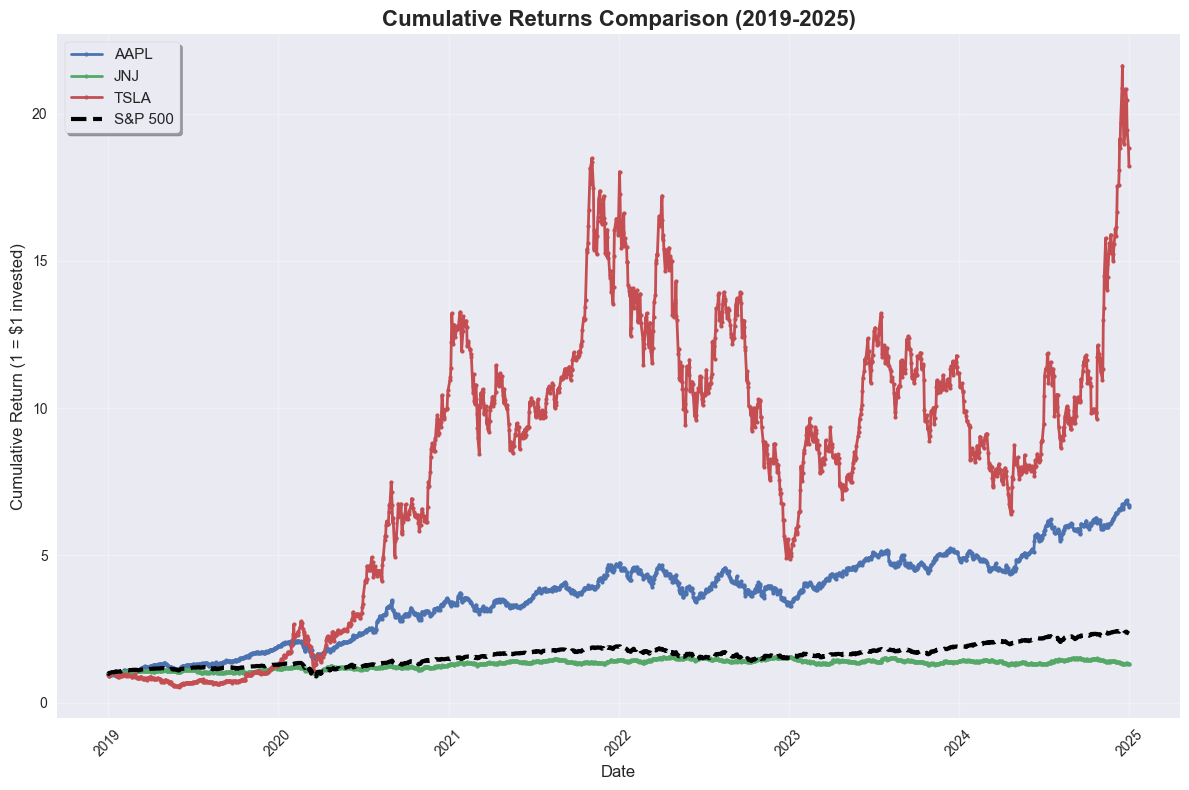
Plot 2: Seaborn - Cumulative Returns with Better Styling#
Now let’s use Seaborn for enhanced styling and aesthetics.
# Plot 2: Seaborn - Cumulative Returns with better styling
plt.figure(figsize=(12, 8))
sns.set_style("whitegrid")
sns.set_palette("husl")
# Prepare data for seaborn
plot_data = []
for ticker in selected_stocks:
ticker_data = stock_cumret[stock_cumret['ticker'] == ticker][['dlycaldt', 'cumret']]
ticker_data['ticker'] = ticker
plot_data.append(ticker_data)
# Add market data
market_plot_data = market_cumret[['dlycaldt', 'cumret']].copy()
market_plot_data['ticker'] = 'S&P 500'
plot_data.append(market_plot_data)
plot_df = pd.concat(plot_data, ignore_index=True)
sns.lineplot(data=plot_df, x='dlycaldt', y='cumret', hue='ticker',
linewidth=2, markers=True, markersize=4)
plt.title('Cumulative Returns: Selected Stocks vs S&P 500', fontsize=16, fontweight='bold')
plt.xlabel('Date', fontsize=12)
plt.ylabel('Cumulative Return', fontsize=12)
plt.legend(title='Asset', fontsize=11)
plt.xticks(rotation=45)
plt.tight_layout()
plt.show()
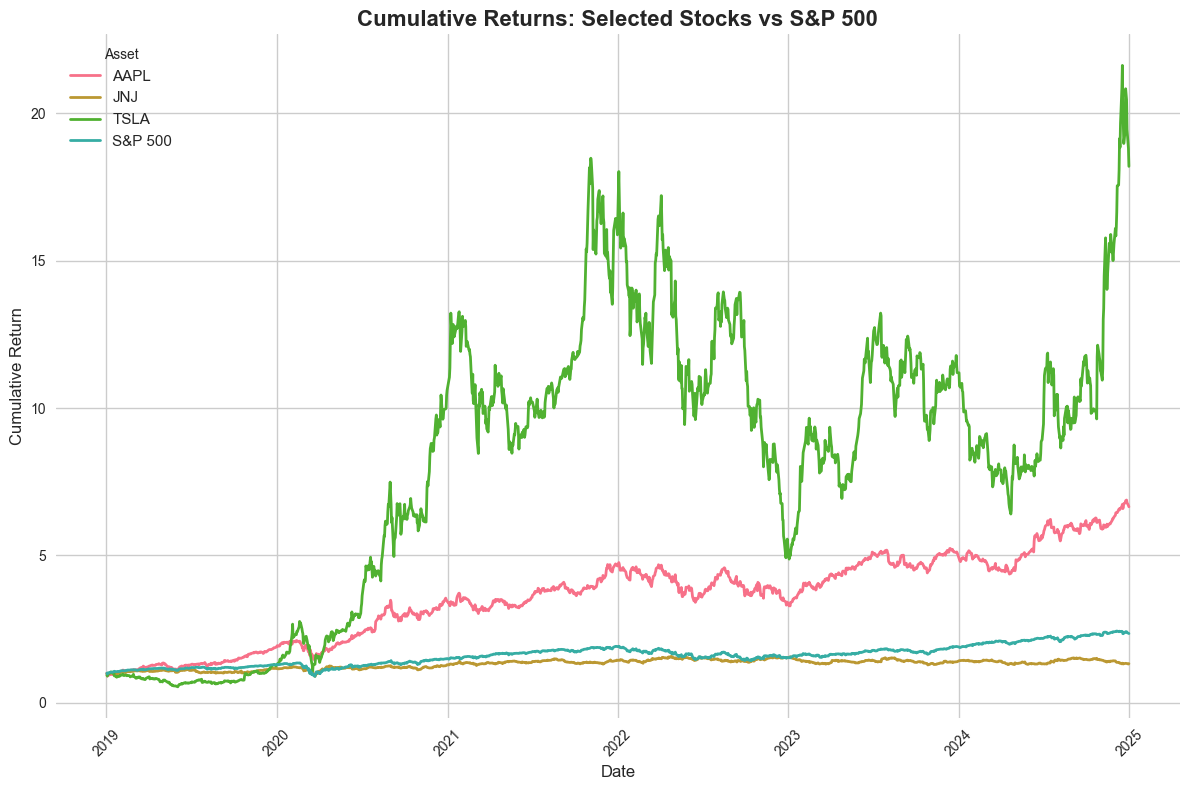
Plot 3: Plotly Express - Interactive Cumulative Returns#
Finally, let’s create an interactive plot using Plotly Express for enhanced user experience.
# Plot 3: Plotly Express - Interactive Cumulative Returns
fig = px.line(plot_df, x='dlycaldt', y='cumret', color='ticker',
title='Interactive Cumulative Returns Comparison',
labels={'dlycaldt': 'Date', 'cumret': 'Cumulative Return', 'ticker': 'Asset'},
line_shape='linear', render_mode='svg')
fig.update_layout(
title_font_size=16,
xaxis_title_font_size=12,
yaxis_title_font_size=12,
legend_title_font_size=12,
hovermode='x unified'
)
fig.show()
Dividend Analysis#
Now let’s analyze dividends to understand the income component of our selected stocks.
# Now let's analyze dividends
print("\n=== Dividend Analysis ===")
=== Dividend Analysis ===
def calculate_cumulative_dividends(data):
"""Calculate cumulative dividends for each stock"""
data = data.copy()
data = data.sort_values(['ticker', 'dlycaldt'])
# Handle potential duplicate dates by taking the last observation for each ticker-date combination
data = data.drop_duplicates(subset=['ticker', 'dlycaldt'], keep='last')
# Sum up all dividend amounts (ordinary + non-ordinary)
data['total_div'] = data['dlyorddivamt'].fillna(0) + data['dlynonorddivamt'].fillna(0)
# Calculate cumulative dividends using a safer approach
data['cumdiv'] = 0.0 # Initialize with 0
for ticker in data['ticker'].unique():
mask = data['ticker'] == ticker
dividends = data.loc[mask, 'total_div']
cumulative = dividends.cumsum()
data.loc[mask, 'cumdiv'] = cumulative
return data
# Calculate cumulative dividends
stock_cumdiv = calculate_cumulative_dividends(selected_data)
# Get dividend summary
div_summary = stock_cumdiv.groupby('ticker').agg({
'total_div': ['sum', 'count'],
'cumdiv': 'max'
}).round(4)
div_summary.columns = ['total_dividends', 'dividend_days', 'cumulative_dividends']
print(div_summary)
total_dividends dividend_days cumulative_dividends
ticker
AAPL 9.37 1510 9.37
JNJ 25.98 1510 25.98
TSLA 0.0 1510 0.00
Plot 4: Matplotlib - Cumulative Dividends#
Let’s visualize the cumulative dividends using matplotlib.
# Plot 4: Matplotlib - Cumulative Dividends
plt.figure(figsize=(12, 8))
for ticker in selected_stocks:
ticker_data = stock_cumdiv[stock_cumdiv['ticker'] == ticker]
plt.plot(ticker_data['dlycaldt'], ticker_data['cumdiv'],
label=f'{ticker} (Total: ${ticker_data["cumdiv"].max():.2f})',
linewidth=2, marker='s', markersize=3)
plt.title('Cumulative Dividends Paid (2019-2025)', fontsize=16, fontweight='bold')
plt.xlabel('Date', fontsize=12)
plt.ylabel('Cumulative Dividends ($)', fontsize=12)
plt.legend(fontsize=11, frameon=True, fancybox=True, shadow=True)
plt.grid(True, alpha=0.3)
plt.xticks(rotation=45)
plt.tight_layout()
plt.show()
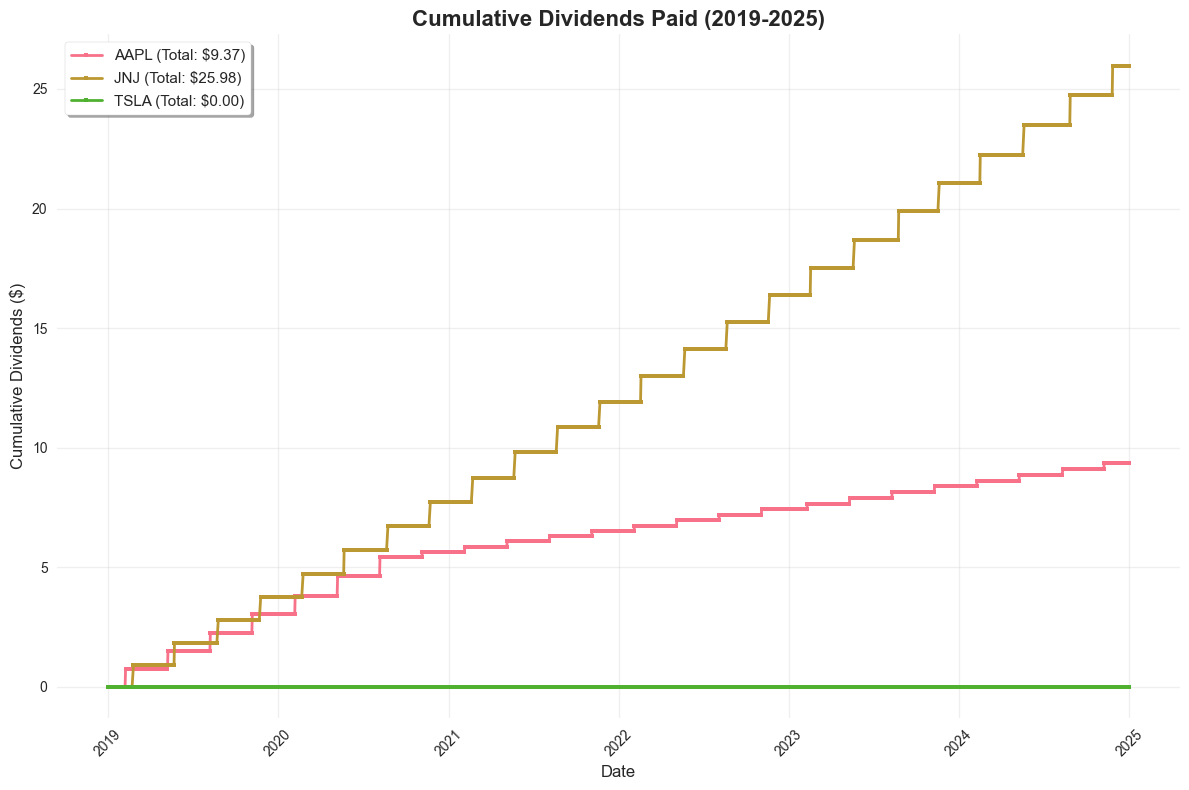
Plot 5: Seaborn - Dividend Comparison#
Now let’s use Seaborn for the dividend visualization.
# Plot 5: Seaborn - Dividend Comparison
plt.figure(figsize=(10, 6))
sns.set_style("whitegrid")
# Prepare dividend data for seaborn
div_plot_data = []
for ticker in selected_stocks:
ticker_data = stock_cumdiv[stock_cumdiv['ticker'] == ticker][['dlycaldt', 'cumdiv']]
ticker_data['ticker'] = ticker
div_plot_data.append(ticker_data)
div_plot_df = pd.concat(div_plot_data, ignore_index=True)
sns.lineplot(data=div_plot_df, x='dlycaldt', y='cumdiv', hue='ticker',
linewidth=2, markers=True, markersize=4)
plt.title('Cumulative Dividends: Selected Stocks', fontsize=16, fontweight='bold')
plt.xlabel('Date', fontsize=12)
plt.ylabel('Cumulative Dividends ($)', fontsize=12)
plt.legend(title='Stock', fontsize=11)
plt.xticks(rotation=45)
plt.tight_layout()
plt.show()
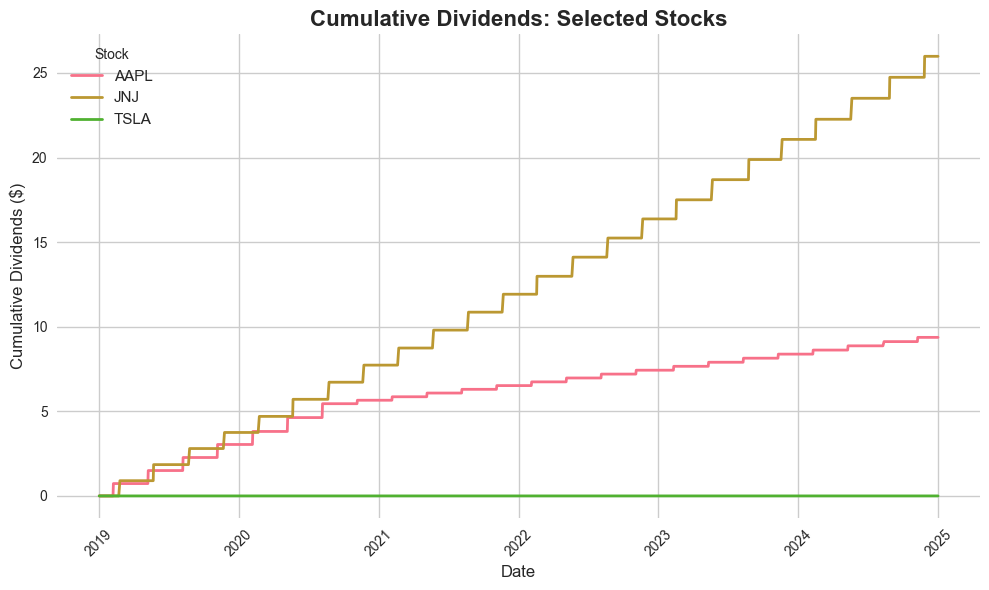
Plot 6: Plotly Express - Interactive Dividends#
Let’s create an interactive dividend plot with Plotly.
# Plot 6: Plotly Express - Interactive Dividends
fig = px.line(div_plot_df, x='dlycaldt', y='cumdiv', color='ticker',
title='Interactive Cumulative Dividends',
labels={'dlycaldt': 'Date', 'cumdiv': 'Cumulative Dividends ($)', 'ticker': 'Stock'},
line_shape='linear', render_mode='svg')
fig.update_layout(
title_font_size=16,
xaxis_title_font_size=12,
yaxis_title_font_size=12,
legend_title_font_size=12,
hovermode='x unified'
)
fig.show()
Rolling Volatility Analysis#
Now let’s analyze the rolling volatility of our selected stocks to understand their risk characteristics over time.
# Now let's calculate rolling volatility (3-month window)
print("\n=== Rolling Volatility Analysis ===")
=== Rolling Volatility Analysis ===
def calculate_rolling_volatility(data, window_days=63): # ~3 months (63 trading days)
"""Calculate rolling volatility for each stock"""
data = data.copy()
data = data.sort_values(['ticker', 'dlycaldt'])
# Handle potential duplicate dates by taking the last observation for each ticker-date combination
data = data.drop_duplicates(subset=['ticker', 'dlycaldt'], keep='last')
# Calculate rolling standard deviation of returns using a safer approach
data['rolling_vol'] = np.nan
data['rolling_vol_annual'] = np.nan
for ticker in data['ticker'].unique():
mask = data['ticker'] == ticker
returns = data.loc[mask, 'dlyret'].fillna(0)
# Calculate rolling standard deviation
rolling_std = returns.rolling(window=window_days, min_periods=30).std()
data.loc[mask, 'rolling_vol'] = rolling_std
# Annualize volatility (multiply by sqrt(252) for daily data)
data.loc[mask, 'rolling_vol_annual'] = rolling_std * np.sqrt(252)
return data
# Calculate rolling volatility for stocks
stock_vol = calculate_rolling_volatility(selected_data)
# Calculate rolling volatility for market
market_vol = market_data.copy()
market_vol['rolling_vol'] = market_vol['sprtrn'].rolling(
window=63, min_periods=30
).std()
market_vol['rolling_vol_annual'] = market_vol['rolling_vol'] * np.sqrt(252)
Plot 7: Matplotlib - Rolling Volatility#
Let’s visualize the rolling volatility using matplotlib.
# Plot 7: Matplotlib - Rolling Volatility
plt.figure(figsize=(12, 8))
for ticker in selected_stocks:
ticker_data = stock_vol[stock_vol['ticker'] == ticker]
plt.plot(ticker_data['dlycaldt'], ticker_data['rolling_vol_annual'] * 100,
label=ticker, linewidth=2, alpha=0.8)
# Add market volatility
plt.plot(market_vol['dlycaldt'], market_vol['rolling_vol_annual'] * 100,
label='S&P 500', linewidth=3, color='black', linestyle='--')
plt.title('Rolling 3-Month Volatility (Annualized)', fontsize=16, fontweight='bold')
plt.xlabel('Date', fontsize=12)
plt.ylabel('Volatility (%)', fontsize=12)
plt.legend(fontsize=11, frameon=True, fancybox=True, shadow=True)
plt.grid(True, alpha=0.3)
plt.xticks(rotation=45)
plt.tight_layout()
plt.show()
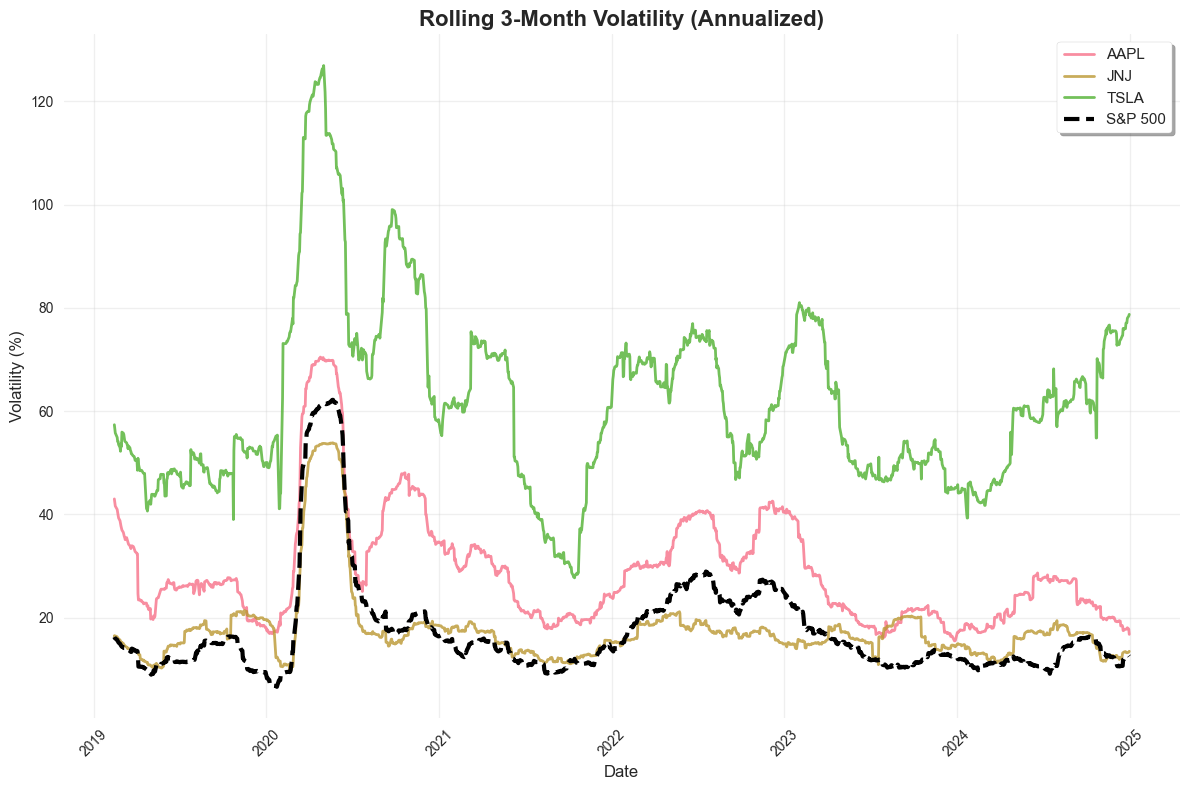
Plot 8: Seaborn - Volatility Comparison#
Now let’s use Seaborn for the volatility visualization.
# Plot 8: Seaborn - Volatility Comparison
plt.figure(figsize=(12, 8))
sns.set_style("whitegrid")
# Prepare volatility data for seaborn
vol_plot_data = []
for ticker in selected_stocks:
ticker_data = stock_vol[stock_vol['ticker'] == ticker][['dlycaldt', 'rolling_vol_annual']]
ticker_data['ticker'] = ticker
vol_plot_data.append(ticker_data)
# Add market volatility
market_vol_data = market_vol[['dlycaldt', 'rolling_vol_annual']].copy()
market_vol_data['ticker'] = 'S&P 500'
vol_plot_data.append(market_vol_data)
vol_plot_df = pd.concat(vol_plot_data, ignore_index=True)
vol_plot_df['rolling_vol_annual'] = vol_plot_df['rolling_vol_annual'] * 100 # Convert to percentage
sns.lineplot(data=vol_plot_df, x='dlycaldt', y='rolling_vol_annual', hue='ticker',
linewidth=2, alpha=0.8)
plt.title('Rolling 3-Month Volatility: Stocks vs S&P 500', fontsize=16, fontweight='bold')
plt.xlabel('Date', fontsize=12)
plt.ylabel('Volatility (%)', fontsize=12)
plt.legend(title='Asset', fontsize=11)
plt.xticks(rotation=45)
plt.tight_layout()
plt.show()
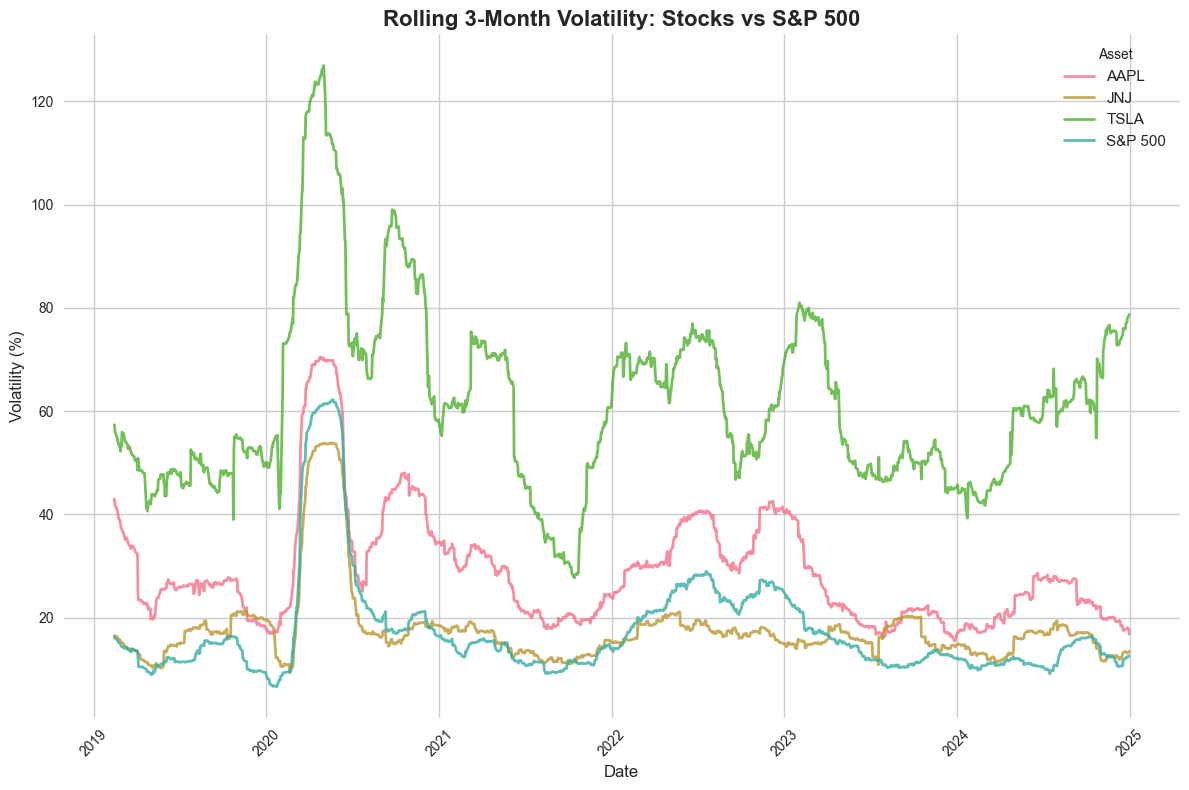
Plot 9: Plotly Express - Interactive Volatility#
Finally, let’s create an interactive volatility plot with Plotly.
# Plot 9: Plotly Express - Interactive Volatility
fig = px.line(vol_plot_df, x='dlycaldt', y='rolling_vol_annual', color='ticker',
title='Interactive Rolling Volatility Analysis',
labels={'dlycaldt': 'Date', 'rolling_vol_annual': 'Volatility (%)', 'ticker': 'Asset'},
line_shape='linear', render_mode='svg')
fig.update_layout(
title_font_size=16,
xaxis_title_font_size=12,
yaxis_title_font_size=12,
legend_title_font_size=12,
hovermode='x unified'
)
fig.show()
Summary Statistics#
Let’s compile a comprehensive summary of our analysis results.
# Summary statistics
print("\n=== Summary Statistics ===")
print("Cumulative Returns (as of latest date):")
for ticker in selected_stocks:
latest_ret = stock_cumret[stock_cumret['ticker'] == ticker]['cumret'].iloc[-1]
print(f"{ticker}: {latest_ret:.2f}x")
latest_market_ret = market_cumret['cumret'].iloc[-1]
print(f"S&P 500: {latest_market_ret:.2f}x")
print("\nTotal Dividends Paid:")
for ticker in selected_stocks:
total_div = stock_cumdiv[stock_cumdiv['ticker'] == ticker]['cumdiv'].iloc[-1]
print(f"{ticker}: ${total_div:.2f}")
print("\nAverage Annualized Volatility (3-month rolling):")
for ticker in selected_stocks:
avg_vol = stock_vol[stock_vol['ticker'] == ticker]['rolling_vol_annual'].mean() * 100
print(f"{ticker}: {avg_vol:.1f}%")
avg_market_vol = market_vol['rolling_vol_annual'].mean() * 100
print(f"S&P 500: {avg_market_vol:.1f}%")
=== Summary Statistics ===
Cumulative Returns (as of latest date):
AAPL: 6.65x
JNJ: 1.32x
TSLA: 18.20x
S&P 500: 2.35x
Total Dividends Paid:
AAPL: $9.37
JNJ: $25.98
TSLA: $0.00
Average Annualized Volatility (3-month rolling):
AAPL: 29.0%
JNJ: 17.7%
TSLA: 61.6%
S&P 500: 17.5%
Analysis Complete#
This script demonstrates:
Matplotlib plotting with pyplot interface
Seaborn plotting with enhanced styling
Plotly Express for interactive visualizations
Cumulative return analysis for selected stocks vs S&P 500
Dividend analysis comparing dividend-paying vs non-dividend stocks
Rolling volatility analysis using 3-month windows
The analysis provides insights into:
Performance comparison between different types of stocks
Income generation through dividends
Risk characteristics over time
Interactive visualization capabilities for data exploration “””
print(“\n=== Analysis Complete ===”) print(“This script demonstrates:”) print(“1. Matplotlib plotting with pyplot interface”) print(“2. Seaborn plotting with enhanced styling”) print(“3. Plotly Express for interactive visualizations”) print(“4. Cumulative return analysis for selected stocks vs S&P 500”) print(“5. Dividend analysis comparing dividend-paying vs non-dividend stocks”) print(“6. Rolling volatility analysis using 3-month windows”)
